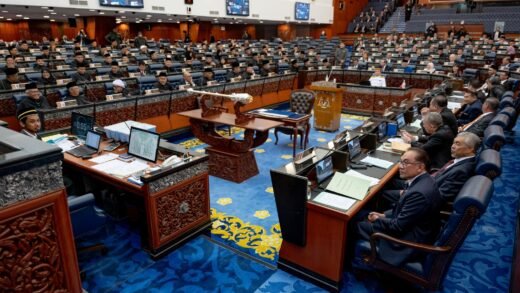
Why is this topic relevant to me?
If your starting salary is below RM5,000, the Government has launched the Progressive Wage Policy to help increase your wages. Want to know how much you can get? Here’s a calculator to help you figure it out easily!
To improve local employees’ wage levels and productivity, the Government has fully implemented the Progressive Wage Policy (PWP) starting this year.
This policy is open to Malaysian citizens who are full-time employees with starting salaries between the current minimum wage and RM4,999. However, it excludes government-linked companies, multinational companies, and specific sectors such as public administration, defence management and activities where self-production cannot be clearly distinguished.
If your employer participates in this policy, do you know how much your salary could increase? Newsgraphy has specially designed a calculator to help you easily determine how much extra you can earn monthly.
Eligible employees can receive salary increases for three years
The Progressive Wage Policy encompasses three core elements:
- Incentive-driven: Eligible companies can receive Government incentives of up to RM200 per month for entry-level employees (less than one year of service) for three years; non-entry-level employees (more than one year of service) can receive RM300 in incentives.
- Voluntary-based: The policy targets employees of micro, small, and medium enterprises (MSMEs) with monthly salaries below RM5,000. This group representing 31% of the country’s workforce, but since the policy is voluntary, the Government expects 50,000 employees to benefit from it, with incentives distributed on a “first-come, first-served” basis.
- Productivity-linked: Participating companies must arrange at least 21 hours of skills training courses for employees to enjoy government subsidies.
The Government have stated that the incentive measures are temporary, aimed at encouraging employers to participate in this policy by increasing employee wages. Once companies can offset wage increases through increased productivity-driven income, the Government will reduce intervention measures and implement an exit policy based on policy effectiveness, fiscal capacity and business competitiveness.
What should my starting salary be?
In conjunction with the Progressive Wage Policy, the Government has introduced the Starting Basic Salaries and Annual Salary Increment Guidelines (“Guidelines”), requiring employers to provide minimum starting salaries for new employees by industry to be eligible for government incentives.
Want to know if your starting salary matches market rates? Simply enter your occupation below to find out:
Which occupation has the highest starting salary? (Every blue dot represent an occupation)
From the chart above, surprisingly, the highest starting salary isn’t for tech specialists, engineers, doctors or lawyers, but for translators, interpreters and linguists, with a starting salary of RM4,675!
The second and third highest-paying professions are Research and Development Specialists, and Social Workers and Counseling Specialists, both with starting salaries exceeding RM4,000. Notably, secondary school teachers rank fifth with a starting salary of RM3,855, even surpassing computer systems analysts and financial investment advisors.
The lowest starting salary is for pawnbrokers and money lenders (RM1,810); the second lowest is for croupiers and related gambling workers, with a starting salary only RM30 higher than the former, matching glass manufacturing workers at RM1,840.
Comparing the highest (translators, interpreters, and linguists) and lowest (pawnshop and money lending staff) starting salaries shows a difference of RM2,865.
How much can my salary increase?
Under the Progressive Wage Policy, beneficiary employees’ salary increases are adjusted according to sectors and occupations defined in the Guidelines. The percentage increases are calculated based on different occupations’ average salaries, plus factors such as inflation.
It’s important to note that employers must raise entry-level employees’ starting salaries according to these guidelines to receive government incentives; for non-entry-level employees, an annual salary increase of at least 6% is required to receive incentives.
Want to know how much your salary could increase? Newsgraphy has specially created a calculator to help everyone easily calculate their salary increase based on their occupation or qualifications!
How progressive wage works in Singapore?

In fact, the Progressive Wage Policy isn’t unique to Malaysia.
Over a decade ago, Singapore implemented the Progressive Wage Model, which established “wage ladders” in specific sectors (such as cleaning, security and landscaping) through phased implementation and mandatory enforcement, ensuring economic security for low-wage employees through gradual salary increases.

While Singapore achieved success through phased implementation and mandatory enforcement, Malaysia has chosen a more relaxed voluntary participation model, particularly targeting MSMEs to reduce their compliance pressure.
According to analysis by the Malaysian Institute of Strategic and International Studies (ISIS), although Malaysia’s model better reduces business compliance burdens, some companies might choose not to participate due to cost considerations, making it difficult to achieve broad policy coverage.
Nevertheless, the government emphasises that the Progressive Wage Policy wasn’t designed based on other countries’ structures but was formulated based on local industrial structures and employment market issues, considering that 97% of domestic businesses are micro, small, and medium enterprises.
Minister of Economy Rafizi Ramli has stated that since the government cannot force employers to raise salaries, encouraging voluntary salary increases must be done through incentives, meaning only employers who raise employee salaries can receive incentives.
Sharing the Economic Pie
Through the Progressive Wage Policy, the government aims to increase employees’ share of GDP (also known as labour income share) from 32.4% in 2022 to 45% by 2033.
What is labour income share?
Labour income share is the portion received by workers (including employees and self-employed individuals). It represents the share of workers’ income in GDP, reflecting income distribution between workers and capital owners. If labour income share is around 50%, it means economic growth benefits are equally shared between workers and capital owners.
However, to truly improve quality of life, besides needing a well-designed policy, we also need to continuously upgrade our skills to maintain a strong position in intense workplace competition.
Data Collection and Analysis: Quinn Soon
Interactive Calculator: Lim Jun Leong
Research and Written By: Lim Yi Hang
Edited and Translated By: Dexter Chan
Follow Newsgraphy’s Facebook and Instagram accounts for stories beyond numbers that matter!
If you find Newsgraphy’s content interesting, feel free to Buy Me a Coffee to provide a small donation and help Newsgraphy to go farther and better!



